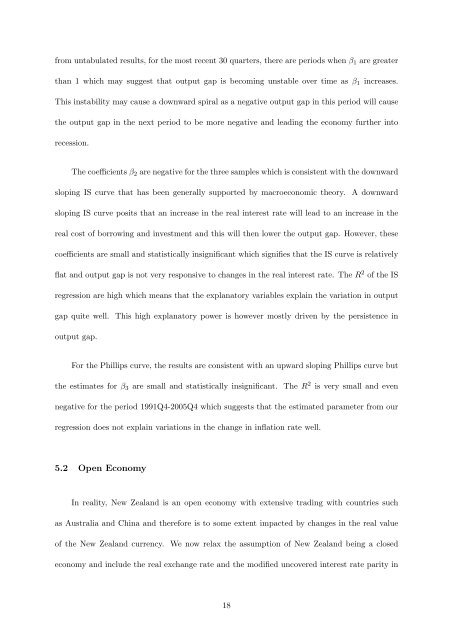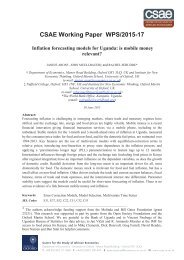You also want an ePaper? Increase the reach of your titles
YUMPU automatically turns print PDFs into web optimized ePapers that Google loves.
from untabulated results, for the most recent 30 quarters, there are periods when β 1 are greater<br />
than 1 which may suggest that output gap is becoming unstable over time as β 1 increases.<br />
This instability may cause a downward spiral as a negative output gap in this period will cause<br />
the output gap in the next period to be more negative and leading the economy further into<br />
recession.<br />
The coefficients β 2 are negative for the three samples which is consistent with the downward<br />
sloping IS curve that has been generally supported by macroeconomic theory. A downward<br />
sloping IS curve posits that an increase in the real interest rate will lead to an increase in the<br />
real cost of borrowing and investment and this will then lower the output gap. However, these<br />
coefficients are small and statistically insignificant which signifies that the IS curve is relatively<br />
flat and output gap is not very responsive to changes in the real interest rate. The R 2 of the IS<br />
regression are high which means that the explanatory variables explain the variation in output<br />
gap quite well. This high explanatory power is however mostly driven by the persistence in<br />
output gap.<br />
For the Phillips curve, the results are consistent with an upward sloping Phillips curve but<br />
the estimates for β 3 are small and statistically insignificant. The R 2 is very small and even<br />
negative for the period 1991Q4-2005Q4 which suggests that the estimated parameter from our<br />
regression does not explain variations in the change in inflation rate well.<br />
5.2 Open Economy<br />
In reality, New Zealand is an open economy with extensive trading with countries such<br />
as Australia and China and therefore is to some extent impacted by changes in the real value<br />
of the New Zealand currency. We now relax the assumption of New Zealand being a closed<br />
economy and include the real exchange rate and the modified uncovered interest rate parity in<br />
18





